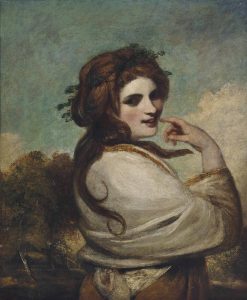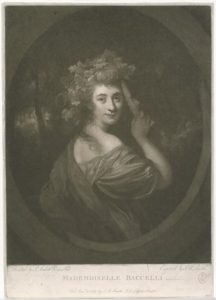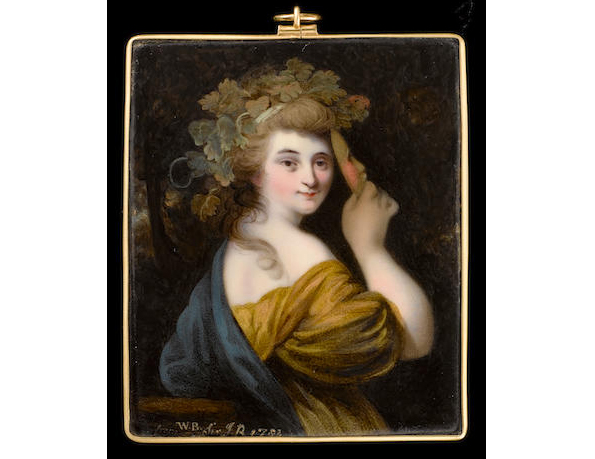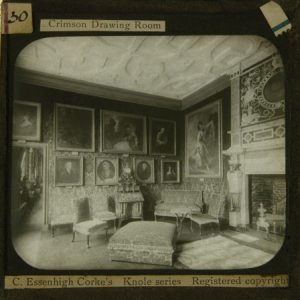New Miniature of Giovanna Baccelli Identified!
The woman garlanded with vine leaves, a coil of dark hair escaped across her shoulders, is identified as Lady Emma Hamilton. And why not? Emma Hamilton (nee Hart) could well be mistaken for the sitter, possessed of thick brown hair herself and arrayed as a classical figure in any number of paintings. But Bonham’s auction house was clearly having a bad day when its specialist slapped the Hamilton label on this miniature by William Bone Senior. Not only because the miniature’s inscription was so carelessly read as to elicit, perhaps, some embarrassment in retrospect, but because the portrait on which this miniature is based is actually relatively well-known. Relatively well-known in the sense that the portrait circulated widely as a mezzoprint during the eighteenth and nineteenth centuries. Relatively well-known in sense that the original portrait is by one of the most celebrated artists of his day: Sir Joshua Reynolds.

This is Emma Hamilton, also painted by Joshua Reynolds. Sold by Christies in 2014. Note Reynolds uses here, as in his Baccell portrait, the seductive device of escaping coils of hair.
Oh well, thank goodness it was tagged as Emma Hamilton, because that’s how I stumbled across the miniature’s auction record from 2007. There I was, innocently googling images of Emma Hamilton as a distraction from my efforts to summarise her contribution to the vogue for neoclassicism, when … my eyes stopped short … “What’s this?!” My brain whirred. “That’s not Emma Hamilton, that’s Baccelli … and I’ve never seen THAT picture of her before!” Several moments of sanctimonious self-aggrandizing followed. “Well, of course it’s Giovanna Baccelli. I mean, duh, Bonhams!! It’s, like, so obvious.”
However, before I got too carried away (and before, good reader, I get to telling you about the antecedents of this miniature), I had to run it past a colleague, past the go-to person for 18th-century dance iconography. In short, I emailed my esteemed friend and colleague Keith Cavers. When it comes to early dance and ballet iconography, we might say that what Keith hasn’t seen isn’t worth seeing. Except that if Keith hasn’t seen it, it jolly well is worth seeing. In fact, it’s quite likely to be something.
My email whizzed around the planet. The sun lit up Keith’s side of the globe several hours later, and the following morning I opened my laptop to find his reply: “WELL DONE !!! – never seen this one before.” I air punched. I indulged the sort of quiet woo-hooing that anyone engaged in a highly esoteric field of study will recognise. One “woo-hoos” naturally enough in pleasure and excitement; but one feels compelled to do so quietly when there are only two or three other people in existence who might appreciate the cause of the commotion. Four or five if you’re lucky. In the case of Baccelli, we might manage to stretch that figure to six.
So what are we dealing with here? Ah, let me present: a 19th-century enamel miniature in a gilt-metal frame, signed on obverse with initials. It has an inscription “W.B./ from Sir J.R 1783″, but the “from” here does not indicate a gift from a random Mr J. R. as Bonhams seemed to assume. Rather it means “after”, as in this miniature is by William Bone (1792-1846) after Sir J[oshua] R[eynolds]. Bonhams, really, how did you overlook that?! Bone was “the fourth son of Henry Bone (1755-1834), enamel painter to George III, George IV and William IV”. Although he did not achieve the artistic recognition enjoyed by his father, the Bones collectively formed a “dynasty of miniaturists and enamellists.”1
The original Reynolds portrait is part of the collection of the Sackville family, preserved at Knole, the family estate at Sevenoaks in England. Although copies of the mezzotint are easily found online and in the collections of several museums, it’s quite tricky to source images of the original portrait. However, the blog of the Knole Conservation Team shows this slide of the Reynolds Room at Knole, dating from the early 20th century. Look closely, and you can see the portrait in the bottom row of pictures, fourth from the left. Right next to Gainsborough’s celebrated full-length portrait of Baccelli, which now hangs in the Tate.
The mezzotint, however, will have to suffice for illustrating the picture on which the miniature is based. As a point of interest, Bonhams opted to identify the portrait as Hamilton in “the guise of Thalia, Muse of Comedy and Idyllic Poetry”, although Reynolds’ original is usually identified simply as Baccelli herself or as Baccelli in the guise of a Bacchante. Reynolds’ oil-on-canvas was commissioned by the Duke of Dorset for a fee of £52.10, paid in February 1783, and was exhibited at the Royal Academy the same year.2 Baccelli was famously Dorset’s mistress. She’s often described as a courtesan too, although I find both “mistress” and “courtesan” problematic given their intimations of a casual relationship and sexual promiscuity. In fact, their union was far more akin to a modern de facto relationship, which began in 1779 and dissolved a full ten years later when Dorset was under pressure to marry a respectable heiress.

Mezzotint of Mademoiselle Baccelli, “Painted by Sr. Joshua Reynolds”, “Engrav’d by J.R. Smith” and “Pubd. Jany. 20. 1783 by J.R. Smith No.83 Oxford Street”. New York Public Library.
The relationship between Dorset and Baccelli was “scandalous”, but was also public knowledge to the extent that newspapers like the Morning Herald expected readers to grasp their intermittent puns and allusions to the union. It’s perhaps fair to suggest that the pair moved within the more liberal social circles of the beau monde and theatre, but given Dorset’s rank and Baccelli’s popularity, the pair avoided the worst punishments of social ostracism. For several years during the 1780s Dorset served as England’s ambassador to France. His official duties and Baccelli’s theatrical commitments often kept them apart for periods. However, at other times they were able to make arrangements enabling Baccelli to dance in Paris while Dorset was in residence there. They had one son who survived to adulthood, and Dorset made provisions for Baccelli when they separated. Fluent in English, French and Italian, Baccelli was an intelligent, adaptable and skilled ally for Dorset. Above all, she was a highly engaging, personable woman, who possessed a warmth of personality that endeared her to many who knew her.
When Reynolds’ portrait was exhibited at the Royal Academy, the Morning Chronicle reported cryptically that it had “much truth of likeness, but not of the most captivating kind. It looks like a copy of her after she had been jaded with hard writing at Knowle.”3 According to the Tate’s publication Gainsborough’s Giovanna Baccelli (still one of the best sources on Baccelli’s career and activities4) there was also a copy of the Reynolds portrait made, recorded as sold by Christie’s in 1896. Presumably that “copy” was another oil, although the existence of this miniature might warrant the record to be double-checked.
In writing this, I’ve assumed (rashly, it suddenly occurs to me) that you know Baccelli was a dancer! Indeed she was, one of the most successful principal dancers at the King’s Theatre in the 1770s and 1780s. Today she remains a person of historical interest given her depictions in art and her connections to Knole and the Sackvilles. I’ve had a long interest in her career through my research into ballet at the King’s Theatre (London’s opera house) in the late 18th century. Baccelli figures in my forthcoming book, and while I don’t necessarily add a lot to what is already known of her life, the book will lend greater context to her career.
Who purchased the Bone miniature when it sold in 2007? Do they realise they have bought a portrait of someone who is not Emma Hamilton, but who is equally, if not more, interesting from the perspective of any registered balletomane? May you enjoy your acquisition wherever you are. There is always room for oohing and ahhing where talented, beautiful and charming Baccelli is concerned.
Now, if you are the owner of Bone’s Baccelli miniature (and you’ve just learned your sitter isn’t Emma Hamilton) … oooh, buy me a coffee … ?
- Roland Arkell, ‘Pick of the Week: William Bone miniature of Holbein’s Henry VIII sells at Warwick auction‘, Antiques Trade Gazette, 4 December 2017. ↩
- Algernon Graves and William Vine Cronin, A History of the Works of Sir Joshua Reynolds (London: 1899), vol. 1, 41 & 257. ↩
- ibid. ↩
- Elizabeth Einberg, Gainsborough’s Giovanna Baccelli (London: Tate Gallery, 1976), 31. ↩



Brilliant deduction as usual – Aunt Jane (Marple) and I are delighted but not surprised – now we have to find the miniature!